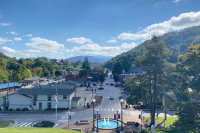Folkmoot celebrates Latin American heritage
Folkmoot USA will present Maritzaida & Raíces Emma-Erwin Latin America Dancers at 7 p.m. Thursday, May 2, at the Folkmoot Friendship Center in Waynesville.
Five strings of fury: New book spotlights Haywood banjo legends
In the mid-1960s, when Bill Allsbrook was a med school student at the University of North Carolina-Chapel Hill, he decided to pick up the banjo.
Living culture: WCU undertakes project showcasing Cherokee heritage on campus
At mid-morning on Wednesday, Nov. 15, the fountain at the heart of Western Carolina University’s campus is a thoroughfare.
Women’s History Trail takes steps to complete sculpture project
The Folk Heritage Association of Macon County (FHAMC) held a groundbreaking ceremony on Oct. 27 after completing a five-year grassroots campaign to raise funds for its Women’s History Trail sculpture.
New book details the history of the John C. Campbell Folk School
In Craft & Community, regional author Anna Fariello presents the early history of Western North Carolina’s John C. Campbell Folk School.
Founded in 1925, the school was a dream of John and Olive Dame Campbell, a working couple who toured the Southern Appalachians in an effort to chronicle its people and their culture.
Sochan in springtime: Cherokee looks to reclaim plant gathering traditions in the Smokies
For centuries and even millennia, the early spring greens of the sochan plant have served as a celebration of spring for the Cherokee people. If a proposal now out for public comment meets approval, in a few months tribal members could hold that celebration with greens harvested in the Great Smoky Mountains National Park.
“Our culture is not linear. It’s more circular, and going back to places like the park, to where we once inhabited and lived and collected, it takes on a different meaning of spirituality,” said Tommy Cabe, forest resource specialist for the Eastern Band of Cherokee Indians and a sochan gatherer himself. “It takes on a different meaning of who we are as Cherokee.”
Monteith remembered as man of the people
When speaking to the many people in Swain County and beyond who knew David Monteith either personally or professionally, they all used the same word to describe him — integrity.
Symbols matter, and so does removing them
 Complicated. Ignorant. Entrenched. It’s easy to come up with words to describe the state of race relations in this country and especially in the South, but some come to mind more easily than others after what happened in Charleston last week. Dylann Storm Roof attended Bible study with black congregants of Emanuel AME Church in Charleston and then summarily gunned down nine of those in the group.
Complicated. Ignorant. Entrenched. It’s easy to come up with words to describe the state of race relations in this country and especially in the South, but some come to mind more easily than others after what happened in Charleston last week. Dylann Storm Roof attended Bible study with black congregants of Emanuel AME Church in Charleston and then summarily gunned down nine of those in the group.
And once again we in this country are forced to confront the ugly reality of racism, compelled to search for ways to turn tragedy into change.
Over the hills and far away: Folk School bridges the essence of humanity
 Taking a left off U.S. 64 onto Settawig Road in rural Clay County, the busy commercial thoroughfare transforms into lush farmland. The mountain air gets sweeter, soothing late spring sunshine spilling into the open windows of your vehicle.
Taking a left off U.S. 64 onto Settawig Road in rural Clay County, the busy commercial thoroughfare transforms into lush farmland. The mountain air gets sweeter, soothing late spring sunshine spilling into the open windows of your vehicle.
A few miles down the winding road, you enter the tiny community of Brasstown, with its one gas station and handful of buildings. You take another left and cross a bridge into Cherokee County. And though that bridge may just seemingly provide transport over the waters of Brasstown Creek, one will soon understand that the threshold is more than meets the eye.
Working to preserve ‘Cherokee Traditions’
 By Anna Fariello • Guest Editorial
By Anna Fariello • Guest Editorial
In writing the text for an exhibition on Cherokee culture a few years ago, I began with this opening line, “Chances are, where you are standing is part of the Cherokee’s ancestral lands.” While, perhaps, I should have hesitated to make such a bold claim of an exhibit that was traveling throughout Western North Carolina, that statement was far from rash. Today, many think of Cherokee as a town at the entrance to the Great Smoky Mountains National Park, while in fact, Cherokee lands once extended to portions of eight modern states.
When The Smoky Mountain News asked me to write this guest editorial, I was in the midst of putting the finishing touches on a talk for Western Carolina University’s annual Native Expo (9 a.m. to 9 p.m. Nov. 12). The expo takes place every November to celebrate and share native cultures with students and the community. Events include talks, film, language, music, and art that celebrate indigenous culture as the university’s contribution to Native American Heritage Month. This year, among other events, the Hunter Library mounted a tribute to the late Robert J. Conley, a prolific and talented writer who served for three years as the university’s Distinguished Sequoya Professor.





